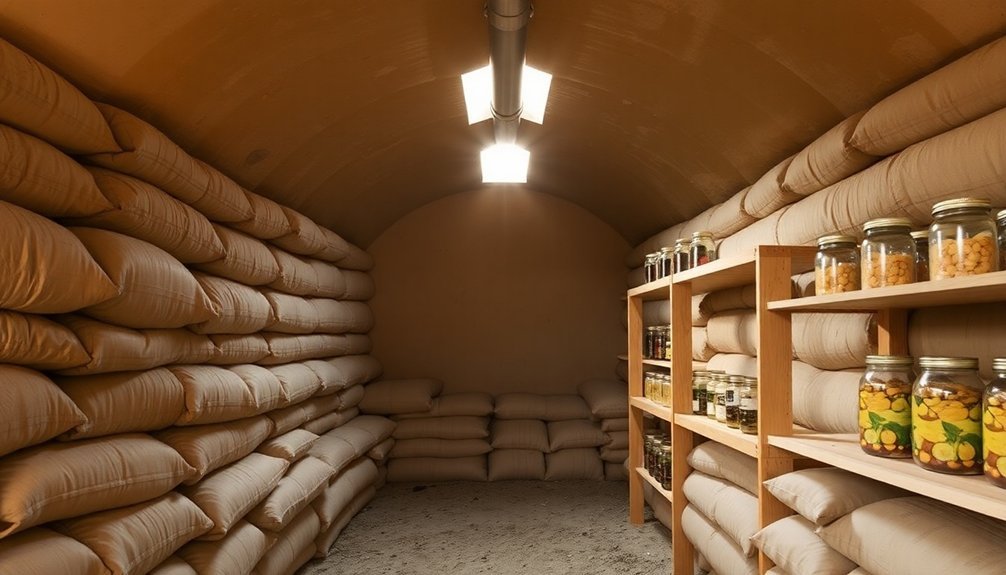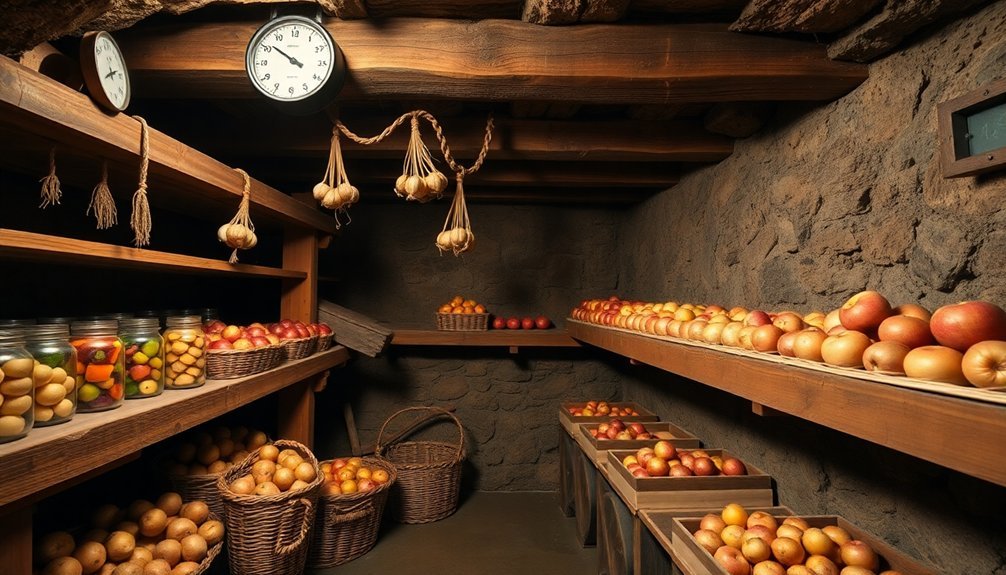You'll find three highly effective root cellar options to preserve your harvest: earthbag, SIPs, and straw bale construction. Earthbag systems offer an affordable DIY approach using soil-filled bags to create a sturdy 6-foot deep structure. SIPs (Structural Insulated Panels) provide superior insulation and airtight storage, though they cost more upfront. Straw bale cellars combine natural materials with excellent R-30 insulation value, making them both eco-friendly and cost-effective. Each method requires proper ventilation and moisture control, but they'll all keep your produce fresh year-round. Let's explore how these innovative storage solutions can transform your food preservation game.
The Earthbag Storage Solution

If you're looking for an affordable and sustainable root cellar solution, earthbag construction offers a robust storage system that won't break the bank. This method uses bags filled with moist soil that you'll tamp down to create solid building blocks, forming sturdy walls that can withstand significant pressure from the surrounding earth.
You'll need to start by excavating a 6-foot-deep hole measuring 8 x 12 feet at the base. After leveling the surface, line the edges with plastic sheeting. The excavated dirt becomes your primary building material, saving you money on materials while putting the displaced soil to good use. With an efficient team, you can expect to fill and place 30 bags in 3.5 hours.
Build your walls by laying earthbags in curved rows for maximum strength, driving rebar through them for added stability. You'll create a solid framework using 2 x 8 lumber as a bond beam across the top of your earthbag walls.
For the roof, incorporate proper insulation using materials like straw bales, which provide excellent R-value. Don't forget to install vent pipes to maintain proper airflow and temperature control.
The result is a durable, temperature-stable storage space that you can build with minimal equipment and materials.
Above-Ground SIPs Design
Three key advantages make Structurally Insulated Panels (SIPs) an excellent choice for above-ground root cellars. First, you'll get superior thermal insulation that maintains consistent storage temperatures.
Second, the panels create an airtight structure that helps control humidity.
Third, you'll benefit from faster construction times compared to traditional building methods.
When you're building with SIPs, you'll start by laying pressure-treated 4x4s as the base to prevent rot. The panels can be cut and spliced to fit your specific dimensions – typically 10 by 8 feet with a 7-foot, 2-inch height works well. Salvaged SIPs can significantly reduce your construction costs.
You'll need to waterproof the panels with Flex Seal and install green sewer pipes for ventilation near the floor and ceiling.
For the flooring, you'll want to use 2x6s with air gaps, treating them with linseed oil and laying landscape cloth underneath to prevent moisture issues.
While SIPs have a higher upfront cost, you'll save money long-term through reduced energy and maintenance expenses.
The foam core construction also offers excellent pest resistance and structural strength, though you'll need to plan carefully since the prefabricated nature limits design changes once construction begins.
Straw Bale Root Cellar

While SIPs offer modern construction benefits, straw bale root cellars provide a more natural and sustainable approach to food storage. By stacking straw bales and covering them with earthen plaster, you'll create walls that offer impressive thermal insulation with R-values reaching up to 30 when set on edge. Adding Portland cement mixture to each bag enhances the structural durability of the walls.
You'll need to focus on proper ventilation by installing vent pipes at both low and high points on opposite sides of your cellar. This setup guarantees efficient air flow, preventing ethylene gas buildup while maintaining the cool temperatures and high humidity necessary for produce preservation.
To enhance your cellar's performance, you can add a pond liner and extra straw bales on top for additional weather protection. The surrounding earth acts as another insulating layer, helping maintain stable internal temperatures.
You'll find this construction method particularly cost-effective since it uses readily available materials that are often repurposed. The sustainability aspect makes straw bale root cellars especially attractive.
You're working with rapidly renewable materials that require minimal infrastructure investment, and you can easily integrate the structure into your garden setting while achieving efficient food storage capabilities.
Frequently Asked Questions
How Long Can Different Types of Vegetables Be Stored in Root Cellars?
You'll find most root vegetables last 5-6 months, with onions and garlic going up to 9 months. Storage life varies based on conditions – carrots, beets, cabbage, and potatoes all store well when properly kept.
What Is the Ideal Temperature and Humidity for a Root Cellar?
You'll want to maintain your root cellar at 32-40°F (0-4°C) with 90-95% humidity. Keep monitoring these conditions using a thermometer and hygrometer to guarantee your vegetables stay fresh for ideal storage.
Can Root Cellars Be Built in Areas With High Water Tables?
Yes, you can build root cellars in high water table areas, but you'll need proper drainage systems, waterproof materials, and elevated construction. It's challenging but doable with French drains and thorough waterproofing methods.
How Much Ventilation Is Needed for Different Root Cellar Designs?
You'll need at least two 3-4 inch diameter vents for small cellars, with more vents for larger spaces. Place intake vents low and exhaust vents high on opposite walls for ideal airflow.
Which Root Cellar Design Is Best for Extreme Weather Conditions?
You'll find the Repurposed Tank Root Cellar most reliable in extreme weather. Its steel-reinforced concrete walls, robust door, and modern filtration systems provide superior protection against storms, floods, and temperature fluctuations.
In Summary
You'll find any of these three root cellar designs can effectively preserve your harvest throughout the year. Whether you choose the cost-effective earthbag system, the quick-to-build SIPs design, or the well-insulated straw bale option, you're making a smart investment in food storage. Select the method that best fits your climate, budget, and available space, and you'll enjoy fresh produce long after harvest season ends.





Leave a Reply